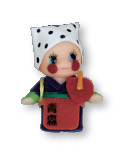Go-Tochi Boom
Author:Jessica Perrin
Topic/Goals:Comparison、Connection、Food、Perspective、School Life、Shopping、Social Environment、Transportation and Travel、Words
2011.06
Students engage with the prefectures and make up of Japan; uncovering the unique specialities of each prefecture in an appealing way through the Kewpie character mascots.
| Objectives | 1. Familiarise students with the makeup/layout/regions and prefectures of Japan |
|---|---|
| Target | Elementary to high school students |
| Japanese Level | Basic |
What to prepare
- Puzzle of Japan (print, laminate and cut out and put into zip lock bags) per group.
- Complete map of Japan (for reference) per group.
- Copy of "Go-Tochi Boom=We Love Local"(PDF format) per group.
- Laptop/Projector/Internet access
Procedure
- Set the class up into groups and give each group a puzzle of Japan. At your command the students should try and put the puzzle together (ensure that there are no maps of Japan around the room!).
- Reconvene and compare the work of each group. Distribute copies of the Japan map to show students the correct makeup. Elicit as much information as possible (Island names, capital, any prefecture names that they know, region names, climate between north and south, where your sister school is etc). Depending on the level of the group you could include location sentences/simple statements like 日本は長いです/大きい島が4つあります。Highlight how many prefectures there are.
- Distribute"Go-Tochi Boom=We Love Local" to each group. As a class read the first part of the article that defines Go-Tochi. Ask students why they think that this is a boom and what they think might be considered popular marks of local identity in Japan.
- Allow students to look at the Kewpie dolls on the page 2 spread. Choose a few as examples to call out.
For example you might say "Find the character for Tokyo. What do you think it represents? Where is Tokyo on the map?"
Repeat for 5-10 characters, encouraging students to repeat the names after you and find the relevant prefecture on the map.
Give information about each character and introduce the concept of めいぶつ i.e. that each area in Japan has its own specialty. This is a great opportunity to discuss the corresponding concept of おみやげ as in many cases the souvenir for others that is brought home from one's travels is the local specialty. If time discuss how this compares to the practices in their own country.NOTE: Don't forget to inform students that each prefecture has other specialities as well i.e. the Kewpie mascot features only represent one of the things the area is famous for. - Assign each group one section of the article to read, summarise and present (Local PR, Food, Go-tochi Guzzu, Language).
After the presentations (if the students didn't utilise the information on the map) draw to their attention the border that divides the eastern and western markets for the Donbei brand of cup noodles/ ask them how many different ways there are of saying とても or つかれた. Student could choose which one they think sounds the best.
If there is time, discuss if the strategies that Japan is using to reinvigorate communities would work in their own country. - Reemphasize the pride of local culture by teaching students how to say what a place is famous for ”~は~がゆうめいです”.
Perhaps start with your own country/area and then return to the prefectures of Japan.
Q:xxxは何がゆうめいですか。
A: xxxがゆうめいです。
For example

Aomori Ringo-musume:
apple-market promotion girlQ: あおもりけんは何がゆうめいですか。
A: りんごがゆうめいです。 - If each group can have access to a computer and the website, you could also run a quiz (in Japanese or English depending on the students ability). Increase the difficulty by giving bonus points if the students can find the prefecture on their map as well.
Q:- What is Aomori famous for?
- Where would you eat grilled beef tongue?
- The delicious Chinese dumplings gyoza are best eaten in?
- Where could you go to get a mikan and what is it?
- Takoyaki is something you could eat in?
- Kyoto is famous for?
- Where would you find whirlpools in Japan?
- For delicious watermelon you should go to?
- apples
- Miyagi
- Tochigi
- Shizuoka
- Osaka
- Geisha in training
- Tokushima
- Kumamoto
NOTE: There are many characters that represent the specialities of each area. This activity could be extended to include other popular mascots such as Hello Kitty and ONE PIECE.









